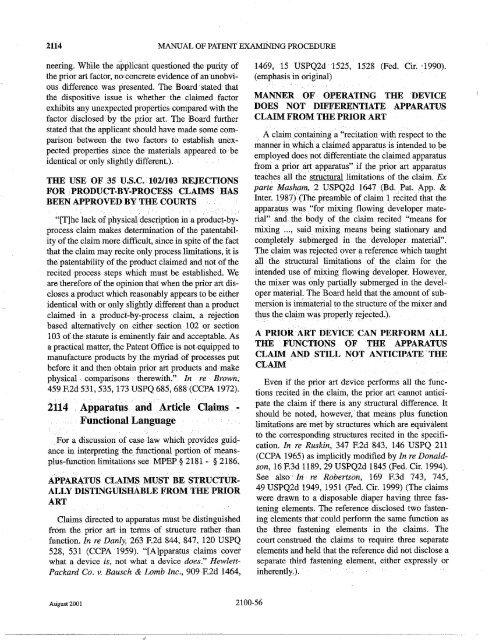The Subject Patent Already Has Underlining or ... - Bayhdolecentral
The Subject Patent Already Has Underlining or ... - Bayhdolecentral
The Subject Patent Already Has Underlining or ... - Bayhdolecentral
Create successful ePaper yourself
Turn your PDF publications into a flip-book with our unique Google optimized e-Paper software.
2114 MANUAL OF PATENT EXAMINING PROCEDURE<br />
neering. While the' applicant questioned the purity of<br />
the pri<strong>or</strong> art fact<strong>or</strong>, no concrete evidence of anunobvions<br />
difference was presented. <strong>The</strong> Board stated that<br />
the dispositive issue is whether the claimed fact<strong>or</strong><br />
exhibits any unexpected properties compared with the<br />
fact<strong>or</strong> disclosed by the pri<strong>or</strong> art. <strong>The</strong> Board further<br />
stated that the applicant should have made some comparison<br />
between the two fact<strong>or</strong>s to establish unexpected<br />
properties since the materials appeared to' be<br />
identical <strong>or</strong> only slightly different.).<br />
THE USE OF 35 UoS.C. 102/103 REJECTIONS<br />
FORPRODUCT·BY·PROCESS CLAIMS HAS<br />
BEEN APPROVED BYTHE COURTS<br />
"[Tjhe lack of physical description ina product-byprocess<br />
claim makes determination of the patentability<br />
of the claim m<strong>or</strong>e difficult, since in spite of the fact<br />
that the claim may recite only process limitations, it is<br />
the patentability of the product claimed andnot of the<br />
recited process steps which must be established. We<br />
are theref<strong>or</strong>e of the opinion that when the pri<strong>or</strong> art discloses<br />
a product which reasonably appears to be either<br />
identical with <strong>or</strong> only slightly different than a prodnct<br />
claimed in a product-by-process claim, a rejection<br />
based alternatively on either section 102 <strong>or</strong> section<br />
103 ofthe statute is eminently fair and acceptable. As<br />
a practical matter, the <strong>Patent</strong> Office is not equipped to<br />
manufacture products by the myriad of processes put<br />
bef<strong>or</strong>e it and then obtain pri<strong>or</strong> art products and make<br />
physical comparisons therewith." In re Brown,<br />
459 F.2d 531, 535, 173 USPQ 685,688 (CCPA 1972).<br />
2114 Apparatus, arid Article Claims -<br />
Fuuctioual Language<br />
F<strong>or</strong> a discussion of case law which provides guidance<br />
in interpreting thefunctional p<strong>or</strong>tion of meansplus-function<br />
limitations see MPEP § 2181 - § 2186.<br />
APPARATUS CLAIMS MUST BE STRUCTUR·<br />
ALLY DISTINGUISHABLE FROM THE PRIOR<br />
ART<br />
Claims directed to apparatus must be distinguished<br />
from the pri<strong>or</strong> art in terms of stmcture rather than<br />
function. In re Danly, 263 F.2d 844, 847, 120 USPQ<br />
528, 531 (CCPA 1959). "[A[pparatus claims cover<br />
what a device is, not what a device does." Hewlett<br />
Packard Co. v. Bausch & Lomb Inc., 909 F.2d 1464,<br />
Augusr2001<br />
2100-56<br />
1469, 15 USPQ2d 1525, 1528 (Fed. Cir. '1990).<br />
(emphasis in <strong>or</strong>iginal)<br />
MANNER OF OPERATING THE DEVICE<br />
DOES NOT DIFFERENTIATE APPARATUS<br />
CLAIM FROM THE PRIOR ART<br />
A claim containing a "recitation with respect to the<br />
manner in which a claimed apparatus is intended to be<br />
employed does not differentiate the claimed apparatus<br />
from a pri<strong>or</strong>art apparatus" if the pri<strong>or</strong> art apparatus<br />
teaches all the structural limitations ofthe claim. Ex<br />
parte Masham, 2 USPQ2d 1647 (Bd, Pat. App. &<br />
Inter. 1987) (<strong>The</strong> preamble of claim I recited that the<br />
apparatus was "f<strong>or</strong> mixing flowing developer material"<br />
and the body of the claim recited "means f<strong>or</strong><br />
mixing ..., said mixing means being stationary and<br />
completely submerged in the developer material".<br />
<strong>The</strong> claim was rejected over li reference which taught<br />
all the stmctural limitations of the claim f<strong>or</strong> the<br />
intended use oflnixing flowing developer. Howeyer,<br />
the mixer was only partially submerged in the developer<br />
material, <strong>The</strong> Board held that the amount of submersion<br />
is immaterial to the stmcture of the mixer and<br />
thus the claim was properly rejected.).<br />
A PRIORART DEVICECAN PERFORM ALL<br />
THE FbNCTIONS OF THE APPARATUS<br />
CLAIM AND STILL NOT ANTICIPATE THE<br />
CLAIM<br />
Even if the pri<strong>or</strong> art device perf<strong>or</strong>ms all the functions<br />
recited in the claim, the pri<strong>or</strong> art cannot anticipate<br />
the claim if there is any stmctural difference. It<br />
should be noted, however,that means plus function<br />
limitations are met by stmctures which are equivalent<br />
to the c<strong>or</strong>responding stmctures recited in the specification.<br />
In re Ruskin, 347 F.2d 843, 146 USPQ 211<br />
(CCPA 1965) as implicitly modified by In re Donaldson,<br />
16F.3d 1189, 29 USPQ2d1845 (Fed. Cir. 1994).<br />
See also'In re Robertson, 169 F.3d 743, 745,<br />
49 USPQ2d 1949, 1951 (Fed. Cir. 1999) (<strong>The</strong> claims<br />
were drawn to a disposable diaper having three fastening<br />
elements. <strong>The</strong> reference disclosed two fastening<br />
elementsthat could perf<strong>or</strong>m the same function as<br />
the three fastening elements in the claims. <strong>The</strong><br />
court construed the claims to require three separate<br />
elements and held that the reference did not disclose a<br />
separate third fastening eleinent, either expressly <strong>or</strong><br />
inherently.),

















